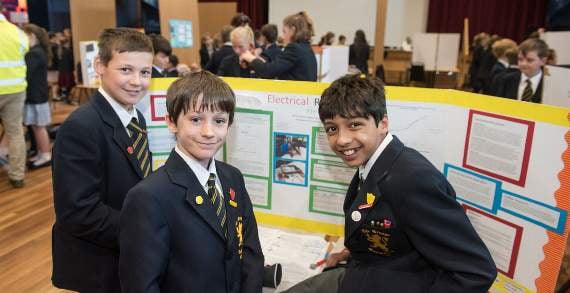BUDDING researchers filled a theatre with colourful posters and props to present a diverse variety of scientific experiments this week.
A hands-on test to see which colour hair generates the most static electricity and a trial to decide if dogs can understand different languages were among the fascinating projects on show at Monmouth School’s Blake Theatre.
33 teams from Prep IV at The Grange and Year 6 at Inglefield House seized the opportunity to explain the results of their hard work to pupils and parents who visited the carefully thought-out stands on Tuesday.
Dr Siôn Wall, science and technology teacher at The Grange, said: “It’s all come together fantastically. The teams have produced an original piece of research having chosen a question which interested them. From that they have drawn conclusions using scientific methods and presented it in a poster and aural form.
“Hopefully, the pupils have gained an understanding of scientific method and how research works – trying and trying until eventually you get a breakthrough.”
There was also a competitive element to the event, with teams vying for the top three slots.
First place was awarded to Head Boy Oliver Lloyd, Roahn Mohindru and Tommy Yeomans for their research on factors affecting electrical resistance of wire.
Under the team name Dr How, the boys presented their work with great enthusiasm.
Dr Wall said: “The judges felt that the boys had carried out their research methodically and understood the science behind their project and presented it very well.”
Oliver, 11, said: “We’ve definitely learned how to work as a team and use scientific methods. There were some problems we had to fix and we had a few debates. Working as a team means that all of our ideas come together.”
Leading the judging panel was Dr Andrew Daniel, Headmaster of Monmouth School. In second place, with their biology-based experiment ‘Underground Picnics’, were Olivia Jones, Jasmine Richardson and Chloe Searle from Inglefield House.
The girls buried packed lunches to see how long they would survive for.
Third position went to ‘Little Einsteins’, Gus Carini-Roberts and Tom Llewelyn, for their chemistry test to discover how different liquids react with sodium bicarbonate.
A presentation proving that cold golf balls travel the furthest in warm weather, a test to find meteor dust in gutter mud, and an experiment to discover if bees can navigate their way around a maze were just a few more of the brilliant pieces of work on show.

Comments
This article has no comments yet. Be the first to leave a comment.